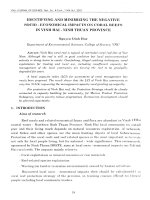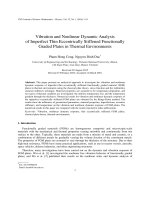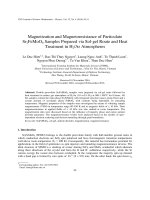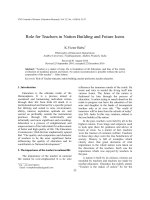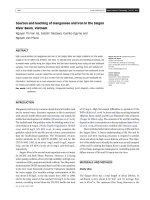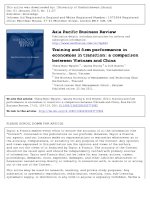DSpace at VNU: Nanostructure and magnetostriction in novel discontinuous terfecohan YFe Exchange-spring type multilayers
Bạn đang xem bản rút gọn của tài liệu. Xem và tải ngay bản đầy đủ của tài liệu tại đây (3.65 MB, 8 trang )
VNU.
jo u r n a l
o f s c i e n c e , M a th e m a tic s - P h y s ic s , T.xx, Ny2, 2004
N a n o s tr u c tu r e a n d m a g n e to s tr ic tio n in n o v e l
D I S C O N T I N U O U S T e r f e c o h a n / Y Fe E X C H A N G E - S P R I N G T Y P E
M U L T IL A Y E R S
Do T h i H u o n g G ia n g , N g u y e n H u u D u e 1, P h a m T h i T h u o n g
Cryogenic Laboratory, Department of Physics, College o f Sciences - V N U
Abstract. Sputtered Tb(Fen--Co,) !-), -/YxFel x multilayers (0 < X < 0.2) with a
T)FeCo layer thickness tn.KpCo - 1 2 nm and YFeCo layer thickness iYi-vr» - 10 nm
hive been studied bv means of the X-ray diffraction (XRD), high-resolution
tnnsmission electron microscopy (HR-TEM), conversion electron Mossbauer
Sfectrometrv (CEMS) and magnetostriction investigations. The results show
tlat nanocrystals are naturally formed and coexist within an amorphous matrix
11 Y,
layers. For this discontinuous exchange-spring multilayers, a
parallel magnetostrictive susceptibility ỵ,j: as large as 29.4x10 “ T 1, which is
almost half of that (79.6x10 T ') of the Metglas 2605SC, was achieved.
1. I n t r o d u c t i o n
M agnetostrictive m a te ria ls a re tran sd u ce r m ateria ls (as well as piezoelectric
and shape memory ones), which directly convert electrical energy into m echanical
energy They are useful in the m anufacture of m icroactu ato rs as well as
microsensors [1-3]. The perform ance of m icroactuators is p rim arily determ in ed by
the value of the m agn etostriction (A), which is the dim ensional chang e resulting
from the orientation of m ag n etizatio n from one direction to an o th er. The
performance of m icrosensors, however, depends r a th e r on the value of th e (parallel)
m agnetostrictive susceptibility, X.Ằ// - cỈẢị/ldB, which re p re se n ts th e m ag neto strictiv e
response to an applied field. For these applications, tra n s d u c e r m a te ria ls in the
form of thin films are of special in te re s t because cost-effective m ass production is
possible, compatible to m icrosystem process technologies.
Most papers concerning g ia n t m agnetostriction published in the la st decade
have been devoted to r a r e - e a r th based films and m ultilayers. As a tra d itio n , various
attem p ts have been m ainly focused on am orphous Terfertol (a-T bFe2) and Terfenol-D
(ơ-TbDyKe,) alloys (Ter for Tb, D for Dy, fe for Fe and nol for Naval O rdnance
Laboratory, w here th ese alloys were discovered) [4]. In the a m o rp h o u s state,
however, it is strongly p referable to su b stitu te the iron by cobalt, because the
amorphous alloys are n e a r th e composition a-TbCo2, t h a t p re s e n ts h igh er ordering
tem p era tu re s and h ig h e r m agneto striction th a n the equivalent Fe-based alloy [5].
1 Permanent address: Academic Affairs Department, VNƯ, 144 Xuan Thuy Road, Cau Giay,
Hanoi E-mail:
1
,
9
,
Do Thi H u o n g G ia n g Nguye n H uu D u e P h a m Thi Thu ong
Because of the im p o rta n t role of th e “L aboratoire Louis N éel” (Grenoble, France) in
th eir development, we have proposed to refer to the a-TbCo.), as “a - T e r c o n é e l by an
obvious analogy to Terfenol. In fact, the m agnetostriction has been optimized in a
series of th in films of the type a-(Tb,Dy)(Fe,Co)2 (a-Terfeconéel-D) [6,7]. Ir. Hanoi,
we have developed the am orphous Tb(Fe0.5f,Co0. 15) 1.5 film (nam ed a-Tcrfecohan, h e re
han m eans Hanoi, i.e. th e capita] where studies of this composition have been
carried out [6,7]). Still b e tte r perform ances were obtained on m agnetostrictive
spring-m agnet m ultilayers, where the sa tu ratio n field of the m agnetostrictive aTbDyFeCo phase is lowered by increasing the average m ag netisatio n through
exchange coupling with the soft-magnetic FeCo layers [2,3 a n d refs, therein].
The conventional m ultilayered concept is usually associating magnetic h a rd
with soft layers, which are stru c tu ra lly homogeneous in e ith er crystalline or
am orphous sta te - nam ed as continuous exchange-spring configuration. In th is
case, m agnetization reversal is th ou ght to be nucleated w ithin the soft layer at low
applied field and pro pagates from the soft layers into the m agnetostrictive layers
[8,9]. The nucleation of reversal usually occurs at defect points on the sample
surface and at interfaces. In this context, one expects t h a t the reversal can be
easier nucleated in discontinuous soft phase, i.e. in lay ers in which the FeCo
nanograins are em bedded w ithin a non-m agnetic m atrix. The idea to prepare this
novel discontinuous
exchange-spring type
m ultilay er
was
applied
for
{Terfecohan/YFeCo} m ultilayers by using the bottom-up approach [6]. In this paper,
we report a direct approach to obtain the n a tu ra lly formed n an o stru ctu re by
controlling the Y-concentration in {TerfecohanlYxFej.J m ultilayers, th a t shows a
great potential to optim ize both large m agnetostriction and large m agnetostrictive
susceptibility.
2. E x p e r i m e n t a l
p
{TerfecoHanlYxF e l x}n m ultilayers with X = 0, 0.1, 0.2, n - 50 and the individual
layer thicknesses t Th\?vC0 - 12 nm and t |.VC0 - 10 nm were fabricated by rf-m agnetron
sp u tterin g at the C en ter for M aterials Science (College of N a tu ra l Science, VNU).
Composite ta rg e ts were consisted of segm ents of different elem ents (here Tb, Y, Fe,
Co) (fig. la). The typical plasm a image for sp u tte rin g power of 200 w a nd the Ar
pressure of 10 2 m bar is showed in fig. lb. The su b s tra te s were glass microscope
cover-slips with a nom inal th ickn ess of 150 //m. Both ta rg e t and sam ple holders
were water-cooled.
The crystal s tru c tu re of sam ples were studied by X-ray diffraction using the
D5005 Siem ens with a cooper anticathode. The sam ple n a n o stru c tu re was
investigated using high-resolution transm ission electron microscopy (HRTEM) at
the In stitu te of Physics, C hem nitz U niversity of Technology (Germany). The
conversion electron M ossbauer spectrom etry (CEMS) was recorded using a
3
NanostiUCture and magnetostriction in novel.
conventional
spectrom eter equipped w ith
a hom em ade
proportional counter. The source was a "C o in rhodium m atrix.
helium -m ethane
39*»
(a)
Fig /. Composite Terfecohan ta g e t (a) and its p lasm a in RF sp u tte rin g (b)
The m agnetostriction was m easured using an optical deflectom eter (resolution
of 5 x l 0 (i rad), in which the bending of the s u b s tra te due to the m agnetostriction in
the films was determ ined.
3. E x p e r i m e n t a l r e s u l t s a n d d i s c u s s i o n s
3.1. Nanostructure
The X-ray 0-20 diffraction resu lts of the in vestigated TerfecohanlYxFe!.x
m ultilayers are shown in fig. 2. One observes a narrow and large intensity
diffraction pick at 20 = 45° in the X = 0 sample, ch arac teristics of the (110)
reflections of bcc-Fe. No other diffraction peaks are observed indicating th a t the
Terfecohan layers are am orphous. The intensity of the (110) reflection pick is
strongly reduced for X = 0.1. This is a ttrib u te d to the form ation of bcc-Fe
nanograins Finally, the (110) reflection alm ost d isap pears a t X —0.2 reflecting the
fact th a t the whole m ultilayer is now amorphous. The corresponding electron
diffraction p a tte rn s (fig. 3a-c) reinforce fu rth e r the conclusions of the X-ray
analysis. The am orphous sta te existing in Terfecohan layers is characterized by the
(typical) first brigh t spread ring from the inside diffraction spot, w hereas the other
rings which are ch aracteristics of the YsFe,.s layers, exhibit d rastically different
behaviours with the variable Y-concentration. They are alm o st complete sh a rp rings
for .V = 0
3a) and spotty rings for X = 0.1 (fig. 3b) indicating the crystalline state
of Fe layers and the nanocrystalline sta te of the Y ,„FeIU) layers, respectively. For X
= 0.2, these rings become spread (fig. 3c) th a t evidence for the am orphous state of
Y(l .2Fen Klayers.
A periodic stripe stru c tu re of smooth and unsm ooth layers in HRTEM-crosssectional m icrograph viewed in Fig. 4a is a good evidence for the m ultilayered
stru ctu re of continuous (amorphous) Terfecohan layers and discontinuous
(nanocrystalline) Y0.1F e 0.9 layers. Dark spots observed in unsm ooth strip es are
4
Do Thi H u o n g Giang, Nguyen Huu Due, P h a m Thi Thuong
noticeable with an average size of the stripe thickness. T hey are a ttrib u te d to bccp e nanograins with an average diam eter of about 10 11111. These nanog rains are
considered as the origin for the weak X-ray diffraction peak and b right spots in the
electron diffraction p a tte rn s already m entioned above in fig. 2 and 3b. Sim ilar
behavior was observed for {TerfecohanlYn ,(Fe,Co)o9} m u ltilay ers [8], For X = 0.2
however, the am orphous s ta te resu lts in a periodic, smooth and homogenous stripe
structu re, see fiIg. 4b.
b c c -F e
ị
'in
c
hTO 3
-0 ■
1 -
\
I
0,2 20
b c c -F e
i
30
I
Angle1(22Ifc
ineia)
eta)
Angle
Fig 2. X-ray sp e ctra
:tra of as-deposited Terfecohan/Y^Fei
TerfecohanlY. T s m u ltila y e rs
Fig 3. Electron diffraction spectra of as-deposited Terfecohan/YsF e ] s m ultilayers
Fig 4. The bright-field high resolution TEM -cross-sectional m ic ro g ra p h s of
TerfeeohanlYxF e l x m ultilayers: (a) X = 0.1 and (b) X = 0.2
Nanostructure and magnetostriction in novel.
5
T ie tran sfo rm a tio n of the am orphous sta te can be associated to the reduction
of the therm odynam ic driving force for crystallisation caused by the Y su bstitution
in the YxFe,.x layers. Sim ilar behaviour was previously rep orted for evaporated
ZxF e lx films [10]. In ref. [10], it was found th a t the am orphous Fe phase is only
stable It small th ickn ess and the crystallisation sets in if the thickness exceeds a
critical value of about 2 nm. The critical thickness can, however, reach a value of 30
nm in the Ftìí);tZr- film ev ap orated on Zr base layers. In general, it is possible to note
t h a t the tran sfo rm a tio n of' the am orphous sta te of Fe is shown to be depended on
the rare-earth (R and/or Y) concentration. The n a n o stru c tu re can be n a turally
formed in as-deposited (R.Y)Fe layers at a critical (R.Y)-concentration Or,.) only.
H ere .V, ~ 0.1. F u r th e r increasing ra re -e a rth content stabilizes the am orphous
state. This is the reason t h a t the Terfecohan phase w ith high Tb-concentration (xTb
= 0.4) always exists in the am orphous sta te in all investigated samples.
3.2. Mõssbauer spectra
Fig. 5 p resen ts the CEM spectra for the as-deposited TerfecohanlYxF e l x
multilayers. For X = 0, the m agnetic sextet of bcc-Fe is p ro m in e n t in the M ossbauer
spectra (fig. 5a). The lines of the sextet are broadening and a param agnetic
contribution occurs in the X = 0.1 sam ple (fig. 5b) and finally, the param agnetic
contribution becomes pro m inent for X = 0.2 (fig. 5c). The spectra have been fitted
with a wide contribution of hyperfine field to ta k e n into account all the
environm ents experienced by Fe57 nuclei. The obtained hyperfine field distributions
P(Bm) are included in figure 5. For X = 0, the P(Bht) can be d istinguished with two
almost se p ara ted components: (i) the low hyperfine-field com ponent with an
average value of <5|,|> = 22 T and (ii) the high hyperfine-field with <Bhf> = 32.5 T.
Taking in to account the fact th a t the P(BM) of the bcc-Fe is ch arac terise d by a peak
at B m = 32.4 T. the observed low hyperfine-field ferrom agnetic phase can be
a ttrib u te d to the a -Terfecohan phase. Indeed, a value of <BM> = 22 T was reported
for single Terfecohan layer film [111- In addition, it is also able to estim ate the Fe
fractions, which a re of 30 % and 70 % in the Terfecohan and Fe layers, respectively.
This is in good a g re e m e n t with those of 28.6 % and 71.4 % deduced for the Fe
concentration in the two corresponding layers. For X = 0.1 (fig. 5b), the low
hyperfine-field ferrom agnetic com ponent with <Bhi> = 22.5 T alm ost rem ains with
fraction A
= 30.5 %. The fraction of the high hyperfine-field ferrom agnetic
component (with <B|,|> = 31.5 T) , however, is reduced (Ar„„. = 54 %) and an
additional p a ra m ag n e tic component with <Bhi> = 4 T and A pill. = 5.5 %, has occurred.
The m easure of the B hf is in agreem en t with the form ation of the Fe nanograins.
The high hyperfine-field ferrom agnetic fraction alm ost d isa p p ea rs in the X- = 0.2
sample (see fig. 5c). For this sample, the major ferrom agnetic contribution
distrib u tes in a broad hyperfine-field range with a m axim um at B M = 22 T and a
,
6
Do Thi H u o n g Gia ng Nguyen H u u Due, P h a m Thi T h u o n g
fraction Afvrv - 65 %. P (B hĩ) shows a minor param agnetic c o m p onent w ith <Bhf> < 10
T and a fraction A p;u. = 35 %.
V e lo c ity (m m /s)
12
20
25
1 02
Fig 5. CEMS and hyperfine-field d istrib u tio n of as-d ep o site d
TerfecohanlYNFe,.Nm u ltila y e rs
3.3. Magnetostriction
The m agnetostriction was m easured in m agnetic fields up-to 0.4 T applied in
plane, parallel and perp endicular to the long side of the sa m p le giving xn and Ầly
respectively. The resu lts of Ả (= Ả„ - À j are presen ted in fig. 6a for as-deposited
films. It is clearly seen that, for X = 0 and 0.1, th e m ag n e to stric tio n is well
developed with a r a th e r large m agnetostrictive su sceptibility a t low fields, reaches
a m axim um and finally decreases at high fields. The observed n eg ativ e contribution
to m agnetostriction is related to the formation of an e x te n d ed dom ain wall at
interfaces, which was already discussed elsewhere [12]. The m a g n e to stric tio n of X =
0.2 sam ple is, however, ra th e r difficult to s a tu r a te due to its perp en d icu lar
anisotropy n a tu re . Low-field parallel m agnetostrictive su sce p tib ility d a ta are
presented in fig. 6b. The m agnetostriction as well as low-field parallel
m agnetostrictive susceptibility reach m axim um values in X = 0.1 sam ple: Ã =
420xl0 r>and Xxn = 17.3x10 2 T The m agnetostriction o b tain ed is com parable to the
value deduced from the d a ta of the single-layer sam p les, e.g. X = 1 080x106 in
Terfecohan [6,7]. For the X = 0.1 sample, the value of X,.// is 4 tim e s la rg e r th a n th a t
of X = 0 and 2 orders larg e r th a n th a t of X = 0.2. This r e s u lts directly from the low
coercivity m echanism proposed above. The (compressive) s tre s s e s existing in assp uttered films are released by low te m p e ra tu re a n n e a lin g (at T A < 350°c for 1
hour). This leads to the change in the orientation of the m agnetic easy axis and thus
enhances noticeably the saturation magnetostriction a n d low-field parallel
magnetostrictive susceptibility. This is clearly evidenced in fig. 7. For X = 0.1 sample, a
large saturation magnetostriction Ả = 720xl0'6 but a low coercivity of 1.1 mT can be
7
Nanostru cture a n d m a g n e to s tr ictio n in novel.
reached. C onsequ ently, X>M achieves a maximal value as large as 29.7x10 ' T ' at
u M = 2.1 mT. The o b tain ed x>.n value is alm ost 30 tim es higher th a n th a t obtained
in Terfenol-D and 4 tim es h ig h er th an th a t obtained in m ultilayers by Q uandt et. al.
[13,14], In com parison w ith the m agnetostrictive Metglas 2605SC (xxn - 79.6x10'- T '),
the obtained X'M v a lu e is still lower [15], but the p resent sam ple shows much larger
m agnetostriction. T his sp e cta cu lar resu lt illu stra te s th e significance of the
approach, which we have developed in view of optim izing both m agnetostriction and
m agnetostrictive susceptibility .
n H (mT)
^oH ( m T )
Fig 6. M a g n e to s tric tio n (a) a n d parallel m agneto strictive su sceptibility h ysteresis
loops (b) of as-d ep o sited TerfecohanlYxFe!.x m u ltila y ers
Fig 7. M a g n e to s tric tio n (a) a n d parallel m agn etostrictive suscep tib ility hysteresis
loops (b) of 350 °C -ann ealed TerfecohanIYxFei.x m u ltila y ers
4. C o n c l u d i n g r e m a r k s
In conclusion we h ave described the direct approach to discontinuous
m agnetostrictive ex ch a n g e-sp rin g m ultilayers, in which the n a n o stru ctu re is
natu rally form ed in YFe soft layers by controlling the Y-concentration. This novel
Do Thi H u o n g Giang, Ngu yen H uu Due, P h a m Thi T h u o n g
8
exchange-spring configuration opens an altern a tiv e ro u te tow ards new highperform ance m agnetostrictive m ate ria ls th a t both large m agneto strictio n a n d large
m agnetostrictive susceptibility can be combined. F u rth e rm o re , it provides a new
generation of exchange-spring m agnetic configuration for studying fu n d a m e n ta l
reversal m echanism .
A c k n o w l e d g e m e n t . This work was supported by th e S ta te P ro g ra m for
Nanoscience and Nanotechnology of Vietnam under the Project 811.204.
R e fe r e n c e s
I.
F. Claeyssen, N. L h erm et , R. Le Letty and p. Bouchilloux, J. Alloys Compd
258(1997) 61.
■>'
N.H. Due, in: Handbook on Physics a n d Chemistry o f the Rare E a r t h s K.A.
Gs~hneirdner, Jr., L. E yring a n d G.H. Lande (Elsevier Science, A m sterdam ),
Vol. 32(2001) 1.
3.
N.H. Due, P.E. Brom m er, in: Handbook on Magnetic Materials, K.H.J.
Buschow ed., (Elsevier Science, A m sterdam ), Vol. 14(2002) 89
4.
A.E. Clark, in: Ferromagnetic Materials, ed. E.p. W ohlfarth, (N orth-H olland
Amsterdam), Vol. 1(1980) 531.
3.
P.E. Brom mer, N.H. Due, in: Handbook on Magnetic Materials, K.H.J.
Buschow ed., (Elsevier Science, A m sterdam ), Vol. 12(1999) 259.
3.
N.HL Due, P.E. Brom m er, in: Encyclopedia o f Materials: Science
Technology, K.H.J. Buschow ed., (Elsevier Science, A m sterdam ), (2004).
7
N.HL Due, J. Magn. Magn. Mater., 242-245(2002) 1411.
3.
N.HL Due, D.T. Huong Giang, N. Chau, J. Magn. Magn. Mater., 265(2004).
9.
D.r. Huong Giang, N.H. Due, V.N. Thuc, L .v. Vu, N. Chau, J. Appl. Phys.
Le t., (2004), in press.
10.
Ư .H err, H. Geisler, H. Ippach and K. Samwer, Phys. Rev., B 59(1999) 13719.
II,
T.M. Danh, N.H. Due, H.N. T h a n h and J. Teillet, J. Appl. Phys., 87(2000)
72)8.
12.
N. H. Due, D. T. Huong Giang, V. N. Thuc, I. Davoli, F. Richomme, J. Magn.
Mcgn. Mater., (2004), in press.
13.
E. Q uandt, A. Ludwig, J. Betz, K. Mackay, D. Givord, J. App. Phys. 81(1997)
5420.
14 .
Ludwig, E. Q uandt, J. Appl. Phys. 87(2000) 4691.
15 .
E. Trém olet de L acheisserise, D. Gignoux, M. Schlenker, Materials and
Applications, Mag netism , Kluwer Academic Publisher, Vol. 2(2002) 227.
and


